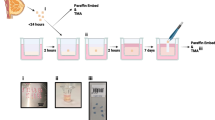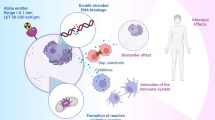Abstract
Breast cancer metastasizes to bone with high frequency and incidence. However, studies of breast cancer metastasis to bone have been limited by two factors. First, the number of models that colonize bone are limited. Second, detection of bone metastases is too insensitive or too laborious for routine, large-scale studies or for studying the earliest steps in bone colonization. To partially alleviate these problems, the highly metastatic MDA-MB-435 (435) human breast carcinoma cell line was engineered to constitutively express enhanced green fluorescent protein (GFP). While 435GFP cells did not form femoral metastases following orthotopic or intravenous injections, they produced widespread osteolytic skeletal metastases following injection into the left ventricle of the heart. All mice developed at least one femur metastasis as well as a mandibular metastasis. As in humans, osseous metastases localized predominantly to trabecular regions, especially proximal and distal femur, proximal tibia, proximal humerus and lumbar vertebrae. 435GFP cells also developed metastases in adrenal glands, brain and ovary following intracardiac injection, suggesting that this model may also be useful for studying organotropism to other tissues as well. Additionally, GFP-tagging permitted detection of single cells and microscopic metastases in bone at early time points following arrival and at stages of proliferation prior to coalescence of individual metastases.
Similar content being viewed by others
References
Ries LAG, Eisner MP, Kosary CL et al. (eds). SEER Cancer Statistics Review, 1973–1999. Bethesda, Maryland: National Cancer Institute 2002.
Body JJ. Metastatic bone disease: Clinical and therapeutic aspects. Bone 1992; 13: S57–S62.
Duivenvoorden WC, Popovic SV, Lhotak S et al. Doxycycline decreases tumor burden in a bone metastasis model of human breast cancer. Cancer Res 2002; 62: 1588–91.
Guise TA. Molecular mechanisms of osteolytic bone metastases. Cancer 2000; 88 (12 Suppl): 2892–8.
Sasaki A, Boyce BF, Story B et al. Bisphosphonate risedronate reduces metastatic human breast cancer burden in bone in nude mice. Cancer Res 1995; 55: 3551–7.
Yoneda T, Williams PJ, Hiraga T et al. A bone-seeking clone exhibits different biological properties from the MDA-MB-231 parental human breast cancer cells and a brain-seeking clone in vivo and in vitro. J Bone Miner Res 2001; 16: 1486–95.
Yoneda T, Sasaki A, Dunstan C et al. Inhibition of osteolytic bone metastasis of breast cancer by combined treatment with the bisphosphonate ibandronate and tissue inhibitor of the matrix metalloproteinase-2. J Clin Invest 1997; 99: 2509–17.
Aslakson CJ, Miller FR. Selective events in the metastatic process defined by analysis of the sequential dissemination of subpopulations of a mouse mammary tumor. Cancer Res 1992; 52: 1399–405.
Yoneda T, Michigami T, Yi B et al. Actions of bisphosphonate on bone metastasis in animal models of breast carcinoma. Cancer 2000; 88: 2979–88.
Price JE, Zhang RD. Studies of human breast cancer metastasis using nude mice. Cancer Metastasis Rev 1990; 8: 285–97.
Welch DR. Technical considerations for studying cancer metastasis in vivo. Clin Exp Metastasis 1997; 15: 272–306.
Miller C, Kiriakova G, Su Kim L et al. Characterization of a novel breast cancer cell line established from a bone metastasis. Proc Am Assoc Cancer Res 2002; 43: 316.
Thompson EW, Sung V, Lavigne M et al. LCC15-MB: A vimentinpositive human breast cancer cell line from a femoral bone metastasis. Clin Exp Metastasis 1999; 17: 193–204.
Sasaki A, Kitamura K, Alcalde RE et al. Effect of a newly developed bisphosphonate, YH529, on osteolytic bone metastases in nude mice. Int J Cancer 1998; 77: 279–85.
Weber MH, Lee J, Orr FW. The effect of Neovastat (AE-941) on an experimental metastatic bone tumor model. Int J Oncol 2002; 20: 299–303.
Wang CY, Chang YW. A model for osseous metastasis of human breast cancer established by intrafemur injection of the MDA-MB-435 cells in nude mice. Anticancer Res 1997; 17: 2471–4.
Thomas RJ, Guise TA, Yin JJ et al. Breast cancer cells interact with osteoblasts to support osteoclast formation. Endocrinology 1999; 140: 4451–8.
Peyruchaud O, Winding B, Pecheur I et al. Early detection of bone metastases in a murine model using fluorescent human breast cancer cells: Application to the use of the bisphosphonate zoledronic acid in the treatment of osteolytic lesions. J Bone Miner Res 2001; 16:2027–34.
Averbuch SD. New bisphosphonates in the treatment of bone metastases. Cancer 1993; 72: 3443–52.
Arguello F, Baggs RB, Frantz CN. A murine model of experimental metastasis to bone and bone marrow. Cancer Res 1988; 48: 6876–81.
Holleran JL, Miller CJ, Edgehouse NL et al. Differential experimental micrometastasis to lung, liver, and bone with lacZ-tagged CWR22R prostate carcinoma cells. Clin Exp Metastasis 2002; 19: 17–24.
Lin WC, Pretlow TP, Pretlow TG et al. Bacterial lacZ gene as a highly sensitive marker to detect micrometastasis formation during tumor progression. Cancer Res 1990; 50: 2808–17.
Culp LA, Lin WC, Kleinman NR. Tagged tumor cells reveal regulatory steps during earliest stages of tumor progression and micrometastasis. Histol Histopathol 1999; 14: 879–86.
Wetterwald A, van der PG, Que I et al. Optical imaging of cancer metastasis to bone marrow: A mouse model of minimal residual disease. Am J Pathol 2002; 160: 1143–53.
Goldberg SF, Harms JF, Quon K et al. Metastasis-suppressed C8161 melanoma cells arrest in lung but fail to proliferate. Clin Exp Metastasis 1999; 17: 601–7.
Hoffman RM. Orthotopic transplant mouse models with green fluorescent protein-expressing cancer cells to visualize metastasis and angiogenesis. Cancer Metastasis Rev 1998; 17: 271–7.
Naumov GN, Wilson SM, MacDonald IC et al. Cellular expression of green fluorescent protein, coupled with high-resolution in vivo videomicroscopy, to monitor steps in tumor metastasis. J Cell Sci 1999; 112: 1835–42.
Yang M, Jiang P, An Z et al. Genetically fluorescent melanoma bone and organ metastasis models. Clin Cancer Res 1999; 5: 3549–59.
Yang M, Jiang P, Sun FX et al. A fluorescent orthotopic bone metastasis model of human prostate cancer. Cancer Res 1999; 59: 781–6.
Cook MJ. The Anatomy of the Laboratory Mouse. New York: Academic Press 1965.
Price JE, Polyzos A, Zhang RD et al. Tumorigenicity and metastasis of human breast carcinoma cell lines in nude mice. Cancer Res 1990; 50: 717–21.
Hoffman RM. Visualization of GFP-expressing tumors and metastasis in vivo. Biotechniques 2001; 30: 1016–26.
Al Mehdi AB, Tozawa K, Fisher AB et al. Intravascular origin of metastasis from the proliferation of endothelium-attached tumor cells: A new model for metastasis. Nat Med 2000; 6: 100–2.
Naumov GN, MacDonald IC, Weinmeister PM et al. Persistence of solitary mammary carcinoma cells in a secondary site: A possible contributor to dormancy. Cancer Res 2002; 62: 2162–8.
Lote K, Walloe A, Bjersand A. Bone metastasis. Prognosis, diagnosis and treatment. Acta Radiol Oncol 1986; 25: 227–32.
Miller F, Whitehill R. Carcinoma of the breast metastatic to the skeleton. Clin Orthop 1984; 184: 121–7.
Nielsen OS, Munro AJ, Tannock IF. Bone metastases: Pathophysiology and management policy. J Clin Oncol 1991; 9: 509–24.
Mbalaviele G, Dunstan CR, Sasaki A et al. E-cadherin expression in human breast cancer cells suppresses the development of osteolytic bone metastases in an experimental metastasis model. Cancer Res 1996; 56: 4063–70.
Sasaki A, Alcalde RE, Nishiyama A et al. Angiogenesis inhibitor TNP-470 inhibits human breast cancer osteolytic bone metastasis in nude mice through the reduction of bone resorption. Cancer Res 1998; 58: 462–7.
Zhang RD, Fidler IJ, Price JE. Relative malignant potential of human breast carcinoma cell lines established from pleural effusions and a brain metastasis. Invasion Metastasis 1991; 11: 204–15.
Sasaki A, Yoneda T, Terakado N et al. Experimental bone metastasis model of the oral and maxillofacial region. Anticancer Res 1998; 18:1579–84.
Sasaki A, Nishiyama A, Alcalde RE et al. Effects of bisphosphonate on experimental jaw metastasis model in nude mice. Oral Oncol 1999; 35: 523–9.
Yang M, Hasegawa S, Jiang P et al. Widespread skeletal metastatic potential of human lung cancer revealed by green fluorescent protein expression. Cancer Res 1998; 58: 4217–21.
Harms JF, Budgeon LR, Christensen ND et al. Maintaining GFP tissue fluorescence through bone decalcification and long-term storage. Biotechniques 2002; 33: 1197–200.
Author information
Authors and Affiliations
Corresponding author
Rights and permissions
About this article
Cite this article
Harms, J.F., Welch, D.R. MDA-MB-435 human breast carcinoma metastasis to bone. Clin Exp Metastasis 20, 327–334 (2003). https://doi.org/10.1023/A:1024062911144
Issue Date:
DOI: https://doi.org/10.1023/A:1024062911144




